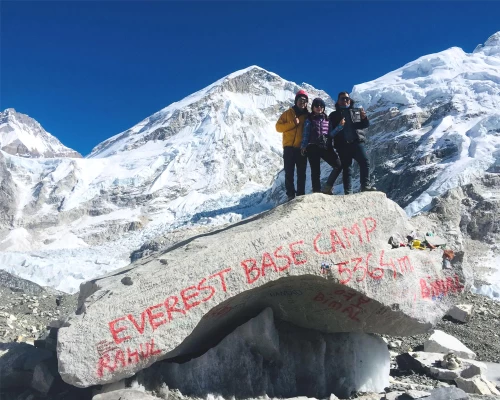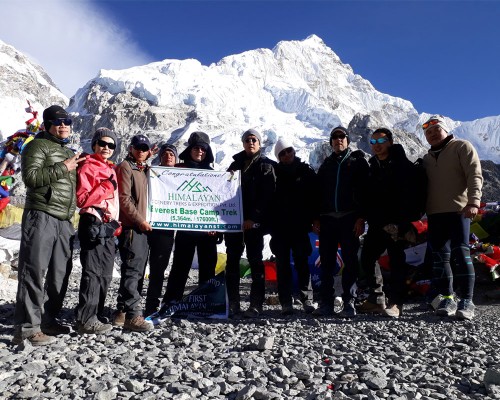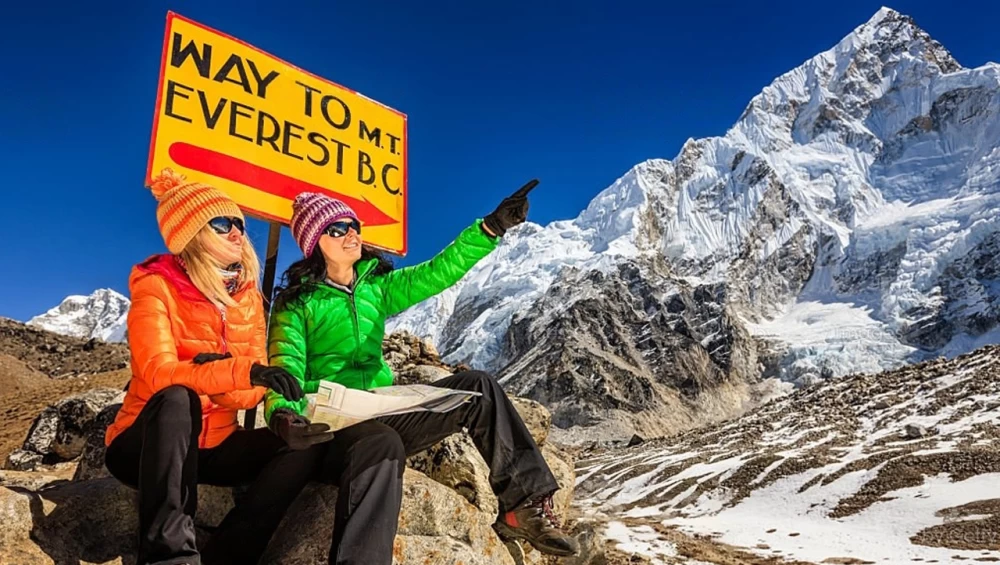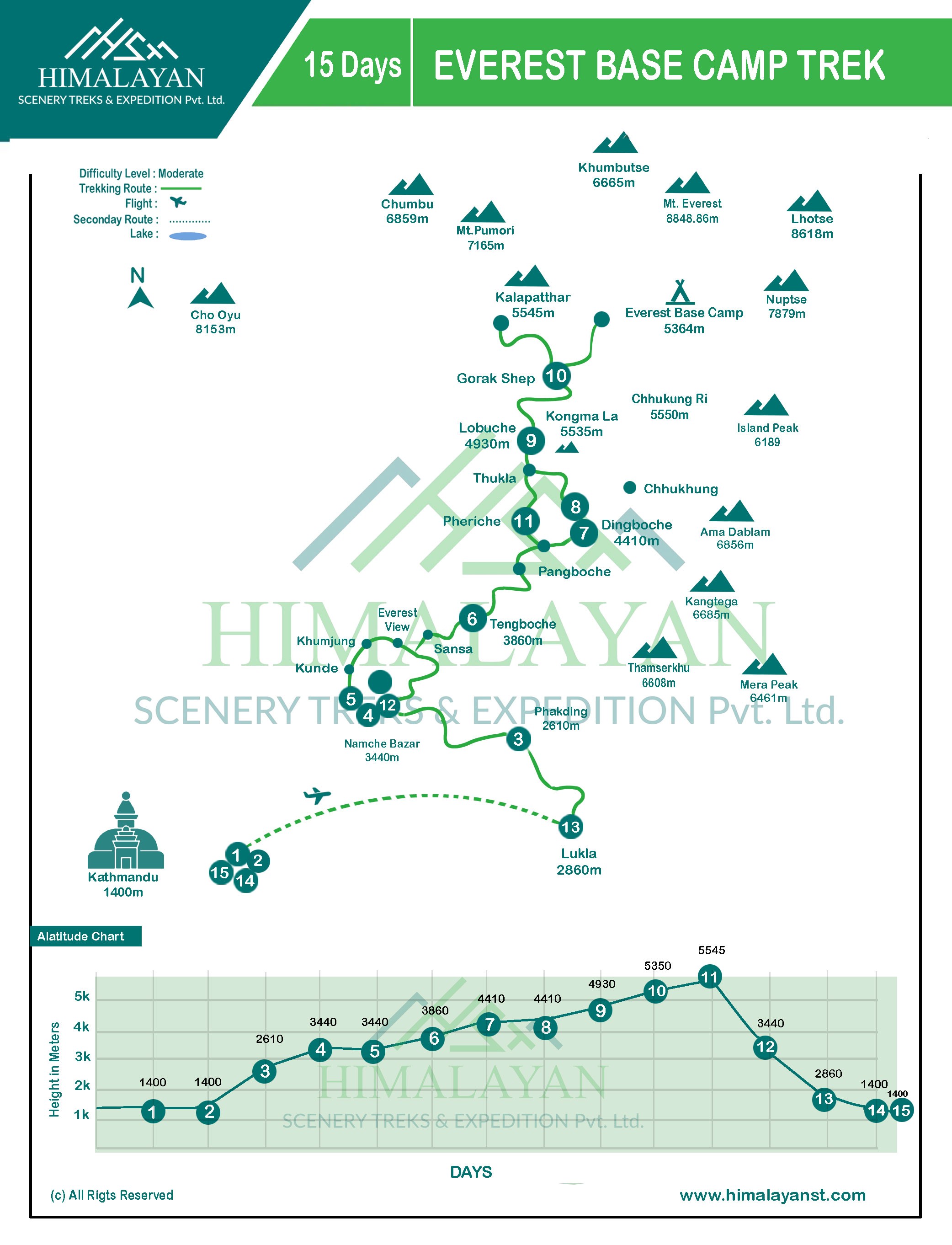Your 15-day Mt. Everest base camp trek begins from Lukla and takes you up to an altitude of (5,545 m. | 18,192 ft.) in Kalapathar. This tour is not just a base camp tour. Throughout the trek, you will be in the warm hospitality of the Sherpa communities. Also, You will be complemented by the mesmerizing melody of the Dudh Koshi River.
Trekkers will be able to visit places like Lukla Airport, Phakding, Namche Bazaar, Everest View Hotel, Tengboche Monastery, Dingboche, Nagarjuna Hill, Lobuche, Gorakh Shep, Everest Base Camp Trek, and Kala Patther. The Sagarmatha Base Camp lies at (5,364 m. | 17,598 ft.) from Gorak Shep, a rendezvous point as it's the last residential area in Khumbu.
Throughout the trek, one can see exotic animals like Snow Leopard, Himalayan Tahr, Red Panda, and Himalayan Monal(Danphe Bird, a national bird of Nepal). Though this might depend upon your luck to get the sight of any of these animals.
Additionally, mountains like Mt. Everest (8,848 meters/29,029 feet), Lhotse (27,940 feet | 8,516 meters), Nuptse (25,771 feet | 7,855 meters), Ama Dablam (6,812 m. | 22,349 feet), Kangtega (6,782 meters | 22,251 feet), and Thamserku (6,623 meters | 21,719 feet) can be seen in this trek.
This Everest Base Camp itinerary promises an affordable cost and an unforgettable transformation from lush greenery to the serene white expanse of the mountains. Though this journey can be difficult for beginners, with our support it can be achieved easily.
Summarized Itinerary To Everest Base Camp
The following plan will leave you with unforgettable moments so be ready.
Day 1: Arrival at Kathmandu | 1,350m (4,428ft)
Day 2: Trek preparation and sightseeing at Kathmandu | 1350m (4,428ft)
Day 3: Fly to Lukla, easy hike to Phakding(2,610 m)
Day 4: Strenuous Hike to Namche Bazaar | 3,440 m (11,286 ft)
Day 5: Acclimatization in Namche Bazaar; hike to Syangboche Airstrip (3,748 m) and Everest View Hotel (3,962 m)
Day 6: Trek from Namche Bazaar to Tengboche Monastery | 3860 m (12665 ft)
Day 7: Tengboche Monstery to Dingboche | 4,410 m (14,469 ft)
Day 8: Acclimatization in Dingboche; hike to Nagarjuna Hill | 14469 ft. (4410 m.)
Day 9: Dingboche to Lobuche | 4,940 m (16207 ft)
Day 10: Lobuche to Gorak Shep to Everest Base Camp | 5,364 m.(17,598 ft) and back to Gorak Shep | 5164 m (16942 ft.)
Day 11: Gorak Shep to Kala Patthar and back to Pheriche | 4,371 m (14340 ft)
Day 12: Pheriche to Namche Bazaar | 3440 m (11286 ft.)
Day 13: Namche Bazaar to Lukla 2846 m (9337 ft)
Day 14: Flyback to Kathmandu and Farewell Dinner | 1350 m (4,429 ft.)
Day 15: Departure from Kathmandu
(Note: The above itinerary can be changed if it doesn’t meet your requirements.)
Best Time for Everest Base Camp Trek
Spring (February to May): Spring is the best season to trek in Khumbu. The skies are so clear which is always the best thing to have when you are going to the mountains. The red forest full of rhododendrons is always mesmerizing in Spring in the Sagarmatha National Park. However, it is quite hard to get enough accommodations during the season.
Autumn (September to December): The mountains are perfectly visible throughout the season. But remember as the mountains surround you, the weather is not so sure during this time. The rhododendron, however, cannot be found during the Autumn. But you will not miss the Danphe and the beautiful Dudhkoshi River's sound along the trail. It might usually snow towards the end of the season.
Difficulty of the EBC Trek
Many travelers have once questioned ‘How hard is it to trek to Everest Base Camp or Can a beginner do Everest Base Camp Trek?’. Don't worry because we are here for that question.
The difficulty of this trek is strenuous where one will be facing unpredictable weather, rough terrain, altitude sickness, and Lukla flight delay. (Also, check the Lukla flight weight limit)
Anyone can accomplish the dream ‘Everest Base Camp Trek’ with enough training or daily exercise for 3 months. Even the imagination of Everest and the other 8000ners surrounding you is admirable and honorable. It’s the saying “High rewards come with a high price,” so act accordingly.
Everest Base Camp Trekking Routes
There are two routes to Everest's base camp. Let's discuss in detail these two routes below:
Classic EBC Route
This Classic Everest Base Camp Trek involves a two-way flight. First, you will go to Lukla on a twin-otter plane booked by our company. This usually involves Sita Air. Then from Lukla, your walk will go for 12 days up and down the hills and mountains in the Everest region. This new route started only after Lukla Airport (Tenzing-Hilary Airport) was constructed in 1964.
The Lukla Airport is still considered the most dangerous airport in the world. But still, the cost of the flights remains the same the flights might be packed during the peak season of the region. So, we recommend you book it right away so that you won't miss Everest. This way your intentional walk will be around 65 kilometers of trail (roughly 40 miles) on the way to the EBC.
Kathmandu-Bupsa/Salleri (Road), Salleri-Lukla-EBC-Lukla Trek and Fly Back to Kathmandu
This trail was the first time explored by none other than Sir Edmund Hillary and his Sherpa Guide Tenzing Norge. The shared jeeps right now can take you up to Bupsa/Salleri. From there only you will start to elevation.
It will take around a day for you to reach Lukla first. After that, you will keep on elevating to Base Camp and come back to Lukla. But don't worry, in our package of Everest Base Camp we have included a fly-back to Kathmandu. Also, the cost of the flight is low, so it is already included.
Also, check Everest Base Camp through Bupsa/Salleri
Note; If you have problems or confusion related to the Everest Base Camp trek or any other tour then, you can rely on our experts: [email protected] or [email protected].
.webp)



















